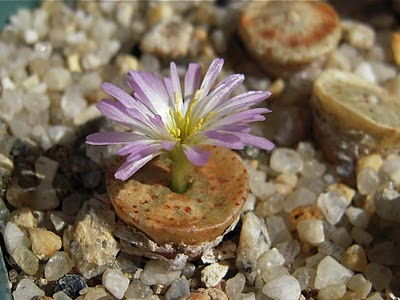 Conophytum bachelorum, with fresh leaves in September (the cone-shaped body is a pair of fused leaves containing water-storing tissue).
Conophytum bachelorum, with fresh leaves in September (the cone-shaped body is a pair of fused leaves containing water-storing tissue). The whereabouts of Conophytum bachelorum was a long term, vexing mystery for students of mesembs (succulent plants in the family Aizoaceae) and living stones. Discovered in the late 1970s, the distinctively purplish button-like succulent was missing in action for decades, known only from dried herbarium specimens and a single living individual cultivated in England. In 2004, C. bachelorum was rediscovered on an obscure quartzite hill in the sparsely populated northwestern corner of South Africa, and a few seeds eventually made their way to mesemb enthusiasts such as myself.
As with many winter-active South African natives, the seeds germinated and grew strongly when planted in early autumn, and coddled for their early years with bright sun and regular doses of dilute fertilizer in the cool months, and some shade and misting in summer to prevent scorching. Conophytum bachelorum seems to be especially sensitive to summer sunburn, which proved fatal to seedlings in the collections of several experienced growers. In the wild, the plants grow close enough to the coast to experience frequent fog, which may explain how they get by in Namaqualand while having such thin skins.
Conophytum bachelorum’s schedule not quite the same as that of the typical Conophytum. The plants flower over an extended period in spring, whereas the overwhelming majority of conos bloom in early autumn. The growing season of C. bachelorum is unusually early, with plants showing a strong tendency to start growing in the waning days of summer if water is available, and to go dormant in late winter (March or even February in the northern hemisphere), weeks or months before most winter-growers fold up shop. As a consequence, the plants flower when they look dormant, covered over by the freshly dried remains of their old leaves.
Young C. bachelorum plants in cultivation, dating from the rediscovery of the wild population, are now flowering and setting seed on a regular basis in several collections around the world. It may be a few more years, but soon enough this neat little succulent should become more generally available.

3 comments:
What an interesting little plant! I am happy to hear they may become more available (that would be awesome)...but I am afraid I might eat mine...they look like a perfect little brownie bite!
Well, more available than it is now; even conophytums that have been in cultivation since the 1930s, are not that frequently encountered!
Lovely post Matt !
Ironically, still no seeds available here in SA, even though we are now in 2012.
Regards,
Etwin
Keep on blogging !
Post a Comment